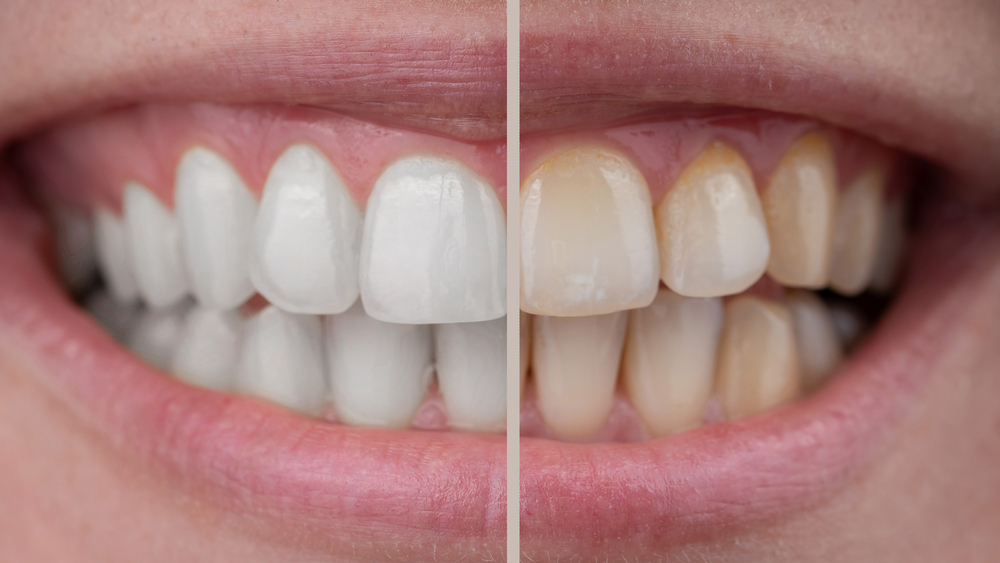What are Teeth Stains?
Teeth stains or teeth discoloration are terms used to describe changes in natural teeth colour i.e., when the teeth appear yellow or less bright. Teeth stains may also be characterized by teeth with dark or white flecks.
Why are My Teeth Stained?
There are many reasons for having stained teeth, such as:
- Poor dental hygiene: If you don’t brush and floss your teeth daily, teeth stains are bound to form over time. Other effects like tooth decay and plaque buildup can also cause tooth color changes.
- Tobacco use: Nicotine and tar from lifestyle habits like smoking tobacco products are known to stain the teeth’s enamel.
- Certain types of foods and drinks: Years of consuming certain foods (i.e., drinking coffee, tea, wine, etc.) is proven to progressively stain teeth.
- Natural age-related discoloration: Tooth enamel tends to wear over time, exposing the underlying dentin that has a yellowish color.
- Genetics: Genetics has also been proven to have an effect on the color of teeth. Factors like the thickness and whiteness of outer enamel are determined by genes. Some people may naturally have teeth enamel that is whiter than others. Some people may also have teeth that don’t respond well to cleaning.
- Dental trauma: If a tooth is damaged badly from an accident, the blood supply can be cut off, resulting in discolouration (gray color inside the tooth).
- Some medication: Lastly, there are some medications like antibiotics commonly administered to children that can stain teeth. Some high blood pressure, antihistamines, and antipsychotic medications also discolor teeth.
Types of Teeth Stains
Teeth stains are generally categorised based on where they occur, affect, or originate from.
a. Extrinsic Stains
Extrinsic stains affect the tooth enamel (outer layer of the teeth). Extrinsic tooth stains are caused largely by foods and drinks. Other causes include poor oral hygiene.
b. Intrinsic Stains
Intrinsic stains affect the layer underneath the enamel (dentin). Intrinsic teeth stains originate inside the teeth and are linked to causes like some medication and dental trauma.
Can You Prevent Teeth Stains?
It depends. Some causes of tooth discoloration, like trauma, medication, and underlying health conditions, can’t be prevented directly. However, other causes of teeth discoloration, like poor oral hygiene and causes linked to eating certain foods and drinks, can be.
Regular brushing and flossing after meals will prevent dental hygiene-related extrinsic tooth discoloration. Reducing the intake of coffee, tea, and dark sodas can also help to lower the risk of teeth stains.
Can You Remove the Stains from Your Teeth?
If you already have teeth stains, don’t worry. You can remove them or seek other remedies. The recommendable options are dictated by factors like the underlying cause.
When it comes to removing stains from your teeth, there are three main recommendable options:
- Professionally applied in-office treatment options available at dental clinics
- Professionally dispensed take-home options prescribed by a dentist but done at home following the instructions of a dentist
- OTC (over-the-counter products) that include self-prescribed remedies like teeth whitening strips and other over-the-counter whitening products
It’s best to consider teeth stain removal options that are recommended and done by a professional dentist or under their strict instructions/supervision to avoid worsening the problem or exposing yourself to serious risks. One of the best approved dental treatments for this situation is a teeth whitening process.
How Does Teeth Whitening Work?
Teeth whitening is a notable solution to teeth stains and for when the teeth aren’t as white as you would like. Teeth whitening works by removing the thin enamel coating that stains over time.
Although there are several teeth whitening systems used, it generally works as follows:
Step 1: Assessment of teeth and gums
Your teeth and gums should be healthy before teeth whitening is recommendable. If there are underlying oral health problems, your dentist will address those first before you can be ready for teeth whitening. The assessment also checks for tooth sensitivity, allergies, tooth shade and more.
Step 2: Treatment
Teeth whitening usually involves using teeth whitening trays and gels. Whitening trays are custom-made for each patient, and a powerful gel is applied to the tray. You should wear your whitening trays and gel for a specified period every day.
Step 3: Results and Other Treatments
Dramatic results can be seen in a few days to three weeks. Treatment can include many procedures aimed at removing teeth stains i.e., dental bonding or veneers, when teeth whitening through whitening trays and gels doesn’t produce a whiter smile.
Come by Annex Dentistry for our Teeth Whitening services
Teeth are bound to stain over time. Even if you brush and floss regularly, your teeth can still stain. If you’d like a healthier and brighter smile, we recommend you book a professional teeth whitening service with us.
Annex Dentistry is a leading Toronto dental clinic that offers various teeth whitening systems. Book an appointment or request a FREE consultation by calling 416-962-4022 or sending an email to [email protected].
